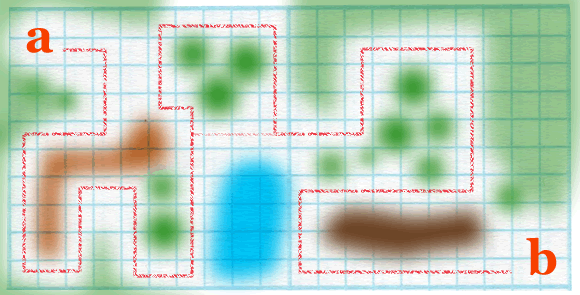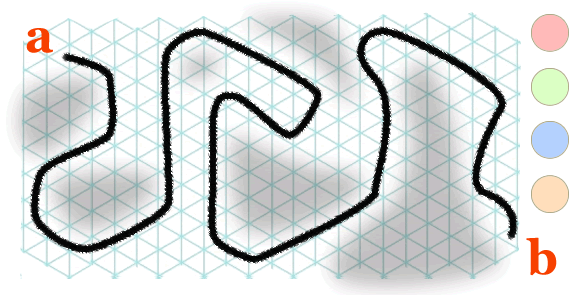
Last year I was invited to be a teaching artist at HOLA, a charter school in Hoboken. I developed a comic-book curriculum for children from K-2. Through 5 weekly classes we reviewed the concepts of character, setting and storyline and each student finished the class with a complete storybook. I've been invited again this year and I'm planning to teach game design. Here is my proposal.
Building a Board Game
My plan is to have each child create a game of their own using graph paper, circular pogs and dice. The first 2 weeks will have us working on a simple maze while the last 3 weeks will be dedicated to creating a larger and more complex game project.
Point A to Point B
Students will first draw a map of a simple path from point "a" to point "b". Squares of the grid will be filled in with colors to represent the terrain of their board, creating a pixel-like pattern of color and texture. Students will learn the basics of grid structure and map making and have fun creating their own mazes and labyrinths.
 Creative Themes
Creative Themes
For the final game project each child will decide on an individual game theme and explore that theme in constructing their boards and playing pieces. Possibilities include penguins on ice, off-road car races, jungle exploration, etc. Younger grades will be able to select from a limited set of options while older classes will have more conceptual freedom to create their own game scenarios.
Making the Rules
The development of rules will be an important component of class time. The game templates will offer a basic set of parameters but students will also have the freedom to create theme-specific rules within those parameters. For example a racing game may have turbo-boost squares that move players forward quickly, while an exploration game may have sticky tar pits that slow a player’s movement. Students will have the flexibility to create their own rules and understand how those rules affect gameplay.
What are the Odds?
Higher grades will explore a tighter, more complex hexagonal grid and use different kinds of dice. Breaking from the standard 6-sided die into 8, 10 and 12 sided dice will help students better understand chance operations and changes in probabilities of outcome.
Shall We Play a Game?
Each student will leave the class with a board game, a set of dice and a set of playing pieces. I may also photograph every child's board and create a compendium of copies for every grade.
 Last year I was invited to be a teaching artist at HOLA, a charter school in Hoboken. I developed a comic-book curriculum for children from K-2. Through 5 weekly classes we reviewed the concepts of character, setting and storyline and each student finished the class with a complete storybook. I've been invited again this year and I'm planning to teach game design. Here is my proposal.
Building a Board Game
My plan is to have each child create a game of their own using graph paper, circular pogs and dice. The first 2 weeks will have us working on a simple maze while the last 3 weeks will be dedicated to creating a larger and more complex game project.
Point A to Point B
Students will first draw a map of a simple path from point "a" to point "b". Squares of the grid will be filled in with colors to represent the terrain of their board, creating a pixel-like pattern of color and texture. Students will learn the basics of grid structure and map making and have fun creating their own mazes and labyrinths.
Last year I was invited to be a teaching artist at HOLA, a charter school in Hoboken. I developed a comic-book curriculum for children from K-2. Through 5 weekly classes we reviewed the concepts of character, setting and storyline and each student finished the class with a complete storybook. I've been invited again this year and I'm planning to teach game design. Here is my proposal.
Building a Board Game
My plan is to have each child create a game of their own using graph paper, circular pogs and dice. The first 2 weeks will have us working on a simple maze while the last 3 weeks will be dedicated to creating a larger and more complex game project.
Point A to Point B
Students will first draw a map of a simple path from point "a" to point "b". Squares of the grid will be filled in with colors to represent the terrain of their board, creating a pixel-like pattern of color and texture. Students will learn the basics of grid structure and map making and have fun creating their own mazes and labyrinths.
 Creative Themes
For the final game project each child will decide on an individual game theme and explore that theme in constructing their boards and playing pieces. Possibilities include penguins on ice, off-road car races, jungle exploration, etc. Younger grades will be able to select from a limited set of options while older classes will have more conceptual freedom to create their own game scenarios.
Making the Rules
The development of rules will be an important component of class time. The game templates will offer a basic set of parameters but students will also have the freedom to create theme-specific rules within those parameters. For example a racing game may have turbo-boost squares that move players forward quickly, while an exploration game may have sticky tar pits that slow a player’s movement. Students will have the flexibility to create their own rules and understand how those rules affect gameplay.
What are the Odds?
Higher grades will explore a tighter, more complex hexagonal grid and use different kinds of dice. Breaking from the standard 6-sided die into 8, 10 and 12 sided dice will help students better understand chance operations and changes in probabilities of outcome.
Shall We Play a Game?
Each student will leave the class with a board game, a set of dice and a set of playing pieces. I may also photograph every child's board and create a compendium of copies for every grade.
Creative Themes
For the final game project each child will decide on an individual game theme and explore that theme in constructing their boards and playing pieces. Possibilities include penguins on ice, off-road car races, jungle exploration, etc. Younger grades will be able to select from a limited set of options while older classes will have more conceptual freedom to create their own game scenarios.
Making the Rules
The development of rules will be an important component of class time. The game templates will offer a basic set of parameters but students will also have the freedom to create theme-specific rules within those parameters. For example a racing game may have turbo-boost squares that move players forward quickly, while an exploration game may have sticky tar pits that slow a player’s movement. Students will have the flexibility to create their own rules and understand how those rules affect gameplay.
What are the Odds?
Higher grades will explore a tighter, more complex hexagonal grid and use different kinds of dice. Breaking from the standard 6-sided die into 8, 10 and 12 sided dice will help students better understand chance operations and changes in probabilities of outcome.
Shall We Play a Game?
Each student will leave the class with a board game, a set of dice and a set of playing pieces. I may also photograph every child's board and create a compendium of copies for every grade.